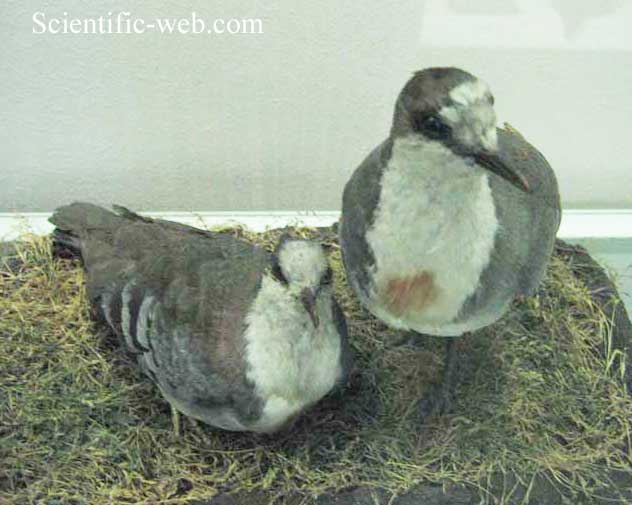
Gallicolumba luzonica, Photo: Michael Lahanas
Superregnum: Eukaryota
Cladus: Unikonta
Cladus: Opisthokonta
Cladus: Holozoa
Regnum: Animalia
Subregnum: Eumetazoa
Cladus: Bilateria
Cladus: Nephrozoa
Superphylum: Deuterostomia
Phylum: Chordata
Subphylum: Vertebrata
Infraphylum: Gnathostomata
Megaclassis: Osteichthyes
Cladus: Sarcopterygii
Cladus: Rhipidistia
Cladus: Tetrapodomorpha
Cladus: Eotetrapodiformes
Cladus: Elpistostegalia
Superclassis: Tetrapoda
Cladus: Reptiliomorpha
Cladus: Amniota
Classis: Reptilia
Cladus: Eureptilia
Cladus: Romeriida
Subclassis: Diapsida
Cladus: Sauria
Infraclassis: Archosauromorpha
Cladus: Crurotarsi
Divisio: Archosauria
Cladus: Avemetatarsalia
Cladus: Ornithodira
Subtaxon: Dinosauromorpha
Cladus: Dinosauriformes
Cladus: Dracohors
Cladus: Dinosauria
Ordo: Saurischia
Cladus: Eusaurischia
Subordo: Theropoda
Cladus: Neotheropoda
Cladus: Averostra
Cladus: Tetanurae
Cladus: Avetheropoda
Cladus: Coelurosauria
Cladus: Tyrannoraptora
Cladus: Maniraptoromorpha
Cladus: Maniraptoriformes
Cladus: Maniraptora
Cladus: Pennaraptora
Cladus: Paraves
Cladus: Eumaniraptora
Cladus: Avialae
Infraclassis: Aves
Cladus: Euavialae
Cladus: Avebrevicauda
Cladus: Pygostylia
Cladus: Ornithothoraces
Cladus: Ornithuromorpha
Cladus: Carinatae
Parvclassis: Neornithes
Cohors: Neognathae
Cladus: Neoaves
Cladus: Columbimorphae
Ordo: Columbiformes
Familia: Columbidae
Subfamilia: Columbinae
Genus: Gallicolumba
Species: Gallicolumba luzonica
Subspecies: G. l. griseolateralis - G. l. luzonica - G. l. rubiventris
Name
Gallicolumba luzonica (Scopoli, 1786)

References
Deliciae florae faunae insubricae 2 p. 94
Vernacular names
čeština: Holub krvavý
English: Luzon Bleeding-heart
Esperanto: Luzona korkolombo
magyar: Luzoni csillagosgalamb
日本語: ヒムネバト
Nederlands: Dolksteekduif
The Luzon bleeding-heart (Gallicolumba luzonica) is one of a number of species of ground dove in the genus Gallicolumba that are called "bleeding-hearts". The native name in Tagalog is punay. It is also known as paloma de punalada 'stabbed pigeon'. The Luzon Bleeding-heart is the species in which the "blood" feature is most pronounced, with the reddish hue extending down the belly, furthering the illusion of blood having run down the bird's breast.
Description
Sylvan Heights Waterfowl Park
On its upper surfaces, the Luzon bleeding-heart is slate grey in color, but because it is iridescent, it can appear to be purple, royal blue, or bottle-green, and the apparent color varies with lighting conditions. On their wings are black bands, while their belly and under wing areas are buff or chestnut.
As in most pigeons, there is little sexual dimorphism; males tend to be larger and have a more pronounced red patch, while in the females it is slightly duller. The body shape is typical of the genus, with a round body, a short tail and long legs.
Distribution
The Luzon bleeding-heart is endemic to the island of Luzon in the Philippines where the locals call it Puñalada. It lives in primary or secondary forests, and can be found at altitudes varying from up to 1400 meters above sea level. They eat seeds, berries and grubs. They are shy and secretive, and very quiet, and rarely leave the ground except when nesting. Unlike the other bleeding-hearts, they usually lay two eggs in each clutch.
Three subspecies of the Luzon bleeding-heart are known: Gallicolumba luzonica luzonica, Gallicolumba luzonica griseolateralis, Gallicolumba luzonica rubiventris.
Gallicolumba luzonica luzonica is found on the central and southern parts of the island of Luzon, and the neighboring Polillo Islands, while Gallicolumba luzonica griseolateralis is found on the northern part of the island. Gallicolumba luzonica rubiventris meanwhile, is found exclusively on the island of Catanduanes where a single specimen was collected in 1971; this subspecies is very rare and believed to be near extinction or already extinct.
Conservation status
Currently, the Luzon bleeding-heart is listed as Near Threatened by the IUCN. This is due to the species being threatened by habitat loss and fragmentation through deforestation for timber extraction and agricultural lands. It is also commonly trapped as a pet for its striking plumage.[1]
A captive breeding project has been started in Australia.[citation needed]
The Luzon bleeding-heart was featured on a Philippine 2-peso postage stamp in 1994.
Luzon bleeding-Heart at Taronga Zoo, Sydney. Taken November 2013
References
BirdLife International (2016). "Gallicolumba luzonica". IUCN Red List of Threatened Species. 2016: e.T22690979A93297883. doi:10.2305/IUCN.UK.2016-3.RLTS.T22690979A93297883.en.
"Appendices". CITES.org. Retrieved 2022-01-14.
Retrieved from "http://en.wikipedia.org/"
All text is available under the terms of the GNU Free Documentation License

